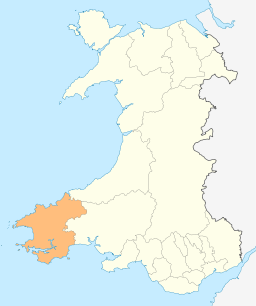St Catherine's Fort
| St Catherine's Fort | |
|---|---|
| Part of Pembrokeshire | |
| Tenby, Wales | |
|
The fort stands on St Catherine's Island next to Castle Rock, Tenby. | |
|
St Catherine's Island and Fort | |
| Coordinates | 51°40′14″N 4°41′31″W / 51.6706°N 4.6919°W |
| Type | Palmerston Fort |
| Height | Up to 14 metres (46 ft) |
| Site information | |
| Owner | Private |
| Site history | |
| Built | 1870 |
| Materials | Limestone Granite |
St Catherine's Fort is a 19th century Palmerston Fort, located on St Catherine's Island, at Tenby, West Wales.
History
Conception
The fort was recommended by the Royal Commission on the Defence of the United Kingdom which had been established in 1859 by Lord Palmerston in response to a perceived threat of invasion by Emperor Napoleon III of France. When considering the defence of the Royal Dockyard at Pembroke Dock and the anchorage at Milford Haven, the Commissioners believed that there was a danger that an enemy force might stage an amphibious landing on a beach on the southern Pembrokeshire coast and attack the naval facilities overland. It was envisaged by the Commissioners that there should be a chain of coastal artillery forts extending along the coast from Tenby to Freshwater West covering all the potential landing sites, but in the event, only the fort at Tenby was constructed.[1]
Design
The design of the fort is credited to Colonel William Jervois.[2] It is a simple rectangular work, consisting of three artillery casemates on two opposite sides, for RML 7-inch guns firing through iron shields. A further three gun platforms for RML 9 inch 12 ton guns are located on the roof. The guns facing north were intended to cover Tenby Harbour and the beach towards Saundersfoot, while those facing south covered the beach towards Penally. The entrance at the western (landward) end of the fort is approached by means of a drawbridge over a dry ditch and is defended by two caponiers or "flanking galleries", each of three storeys pierced with loopholes for small arms fire. At the eastern end at basement level are located the powder magazine and shell store. There was accommodation for a garrison of 150 men.[1]
Construction
St Catherine's Island was purchased from The Corporation of Tenby for £800 in 1866. In 1867 work began clearing the site and constructing the slopes and cranes for the mammoth task of lifting solid granite blocks onto the island. Construction was undertaken by a local builder, George Thomas of Pembroke, and was overseen by Colonel W. Llewelyn Morgan, Captain Fredrick Clements and Sergeant Gibbs, all of the Royal Engineers. The work was completed but not armed by 1870 at a cost of £40,000,[2] and the gun shields were finally installed in 1886. In that year, a report to the Defence Committee described the heavy 9 inch guns as "useless".[1]
Later use
In 1895, control of the fort passed to the Royal Naval Reserve, who emplaced a single BLC 5 inch gun on a "Youngman’s compression platform", apparently for training purposes. In 1907 the fort was decommissioned and sold to the Windsor Richards family who converted it into a private house. The gun shields were replaced by windows and the interior was lavishly decorated, although the fort was apparently garrisoned by the army during the First World War. During Second World War, the fort was compulsory purchased in 1940 and the house contents were auctioned by Harrods. During the war when an anti-aircraft battery was built in front of the fort; units serving there included the Royal Marines, 4th Defence Battery and a Light Anti-Aircraft Battery of the Royal Artillery, a detachment of the Belgian Army, the Home Guard and an Air Sea Rescue detachment of the RAF.
After the war the fort was again decommissioned and sold to a local solicitor who let it to various tenants including Norman Lewis the author. It was sold again in 1962 and in 1968 the fort was opened as a zoo; in 1979 it relocated to new premises leaving the fort empty.[2] It became a Grade II* Listed Building in 1951 because it was considered "an important later 19th century naval fort, superbly built and prominently sited".[3]
Present day

St Catherine's Fort is empty however work is underway to restore the fort and open it to the public. In May 2015, it was announced that Pembrokeshire Coast National Park Authority had approved an application to reopen the site to the public, due to the economic benefit that it would bring to the area. The site will contain a nature walk, boat landings, commercial and catering outlets, in addition to restoration of the fort.[4] During restoration, the fort is open to visitors at weekends in the holiday season, subject to the state of the tides.[5]
External links
| Wikimedia Commons has media related to St Catherine's Fort, Tenby. |
- Official website
- Official Photographs
- Map sources for St Catherine's Fort
References
- 1 2 3 "St. Catherine's Fort, Tenby" (PDF). www.victorianforts.co.uk. Victorian Forts and Artillery. Retrieved 18 May 2016.
- 1 2 3 "Catherine's Island and Fort - History". tenbyisland.co.uk. The Tenby Island Project. Retrieved 18 May 2016.
- ↑ Saint Catherine's Fort, Tenby www.BritishListedBuildings.co.uk, accessed 28.05.15
- ↑ St Catherine's Island fort off Tenby to open to visitors Article, www.BBC.co.uk, 27 May 2015
- ↑ "Catherine's Island and Fort - Introduction". tenbyisland.co.uk. The Tenby Island Project. Retrieved 18 May 2016.


